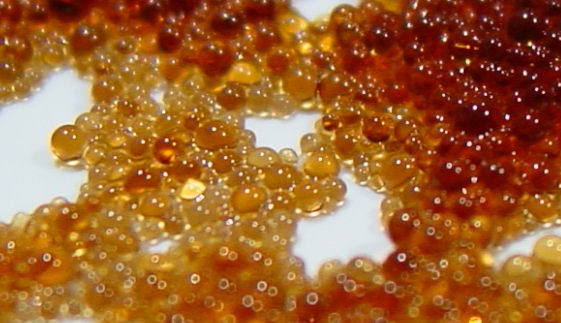Ion Exchange Polymers: The Hidden Helpers of Clean Water and Industry
At Mapril, we strive for a clear understanding of complex technologies. One such technology is an ion exchange polymer: practically an invisible power in many day-to-day processes. You may not have even heard the term in your life, but if you have had water softened for your consumption, for instance, had clearer soda to drink, or used a gadget made in ultra-pure materials, you have benefitted from it.
This piece disassembles the ion exchange polymers and their working principle, how are they important, and where can you see them at work.
What Is an Ion Exchange Polymer?
Consider this: An ion exchange polymer is your sponge with a special gift. It is unlike a kitchen sponge that absorbs water; these polymers consist of minute beads or membranes having charged sites that interchange unwanted substances (ions) in water or solutions for more desirable ones.
The ion exchange polymer traps calcium (Ca²⁺) or magnesium (Mg²⁺) ions from hard water and releases sodium (Na⁺) ions in exchange. The resultant soft water helps prevent scaling in piping and appliances.
Simply put, those polymers can be considered gatekeepers, which says which particles should stay and which should go from the place.
How Do They Work?
The procedure sounds very technical, but the basis of it is rather simple:
1. Contact–Water or any other liquid passes through the polymer beads.
2. Swap–The polymer exchanges its own “stored” ions with the ions thinking in the water.
3. Exhaustion–As time passes, the polymer is “loaded” with unwanted ions and starts becoming inefficient.
4. Regeneration–The polymer is “recharged” by washing it with the strong solution that washes out the trapped ions, ready to be used again.
Types of Ion Exchange Polymers
Not all ion exchange polymers are equal, as they serve different purposes. In general, they are classified under two headings:
– Cation exchangers: Take up particles that are positively charged, such as calcium, magnesium, or heavy metals.
– Anion exchangers: Take up particles that are negatively charged, such as chloride, sulfate, or nitrate.
Some work under all conditions, and some only under specific ones. Their nature also defines their speed and efficiency: gel-like or more porous.
Why Are They Important?
The consideration towards ion exchange polymers arises from their roles across industries with purification, protection, and efficiency improvement:
– Clean water – They remove hardness and unwanted salts from water, making it fit for use in households and industries.
– Efficiency – They soften water to avoid scaling in boilers, pipes, and machines, thus saving energy and maintenance costs.
– Purity – Ion exchange ensures ultra-clean water and materials for pharmaceuticals and electronics, where minute impurities can besmirch the products.
– Sustainability – Since these polymers can be regenerated and used multiple times, they cut back on some waste and resource usage.
Everyday Applications
Yet, the very person would be surprised to know just how much the ion exchange polymers interact with their life. Some instances:
- Water Softeners – By far the most common use wherein hard water is softened to protect household appliances.
- Drinking Water Purification – Removal of harmful substances such as nitrates and heavy metals.
- Food and Beverage – Used in the purification of sugar syrups and fruit juices and in the improvement of taste and clarity of beverages.
- Pharmaceuticals – Ensuring medicines are made with the purest possible ingredients.
- Electronics– It would be to produce ultra-pure water for microchips and sensitive components.
- Environmental Protection–To clean industrial wastewater before discharging it back into rivers or lakes.
Benefits at a Glance
-Removing unwanted particles efficiently.
-Can be regenerated and used over and over.
-Wide range of uses for home and heavy industrial purposes.
-Important for high-quality type-using pure products.
Challenges to Keep in Mind
– Chemical wastes-The regeneration process gives rise to some wastewater which has to be disposed of safely.
– Fouling-Soils, oils or certain chemicals will clog the polymer and reduce its performance.
– Cost-Initial installation is said to be expensive with large systems but cheaper when minimized.
The Future of Ion Exchange Polymers
The research is undergoing constant improvement toward the following developments:
– Durability- Higher durability means polymers are allowed longer life before the need for replacement.
– Selectivity- Targeting contaminants in a more efficient way.
– Environment services- Greener regeneration processes that involve safer chemicals also reduce the amount of waste.
– Special application-From the recovery of valuable metals to treatment of radioactive wastes.
Conclusion
Although not visible to the naked eye at our daily lives, ion exchange polymers give gentle protection to water, food, medicines, and technologies. When calcium compounds are present in hard water, such polymers soften the tap water to humanity’s joy and to aid industry to the highest purity standards-the truly unsung heroes.
At Mapril, it stays true to the idea such materials have on building a cleaner, efficient, and sustainable future. Familiarity with the basics of ion exchange polymers heightens appreciation of how these come into play-industrially as well as in day-to-day living.

